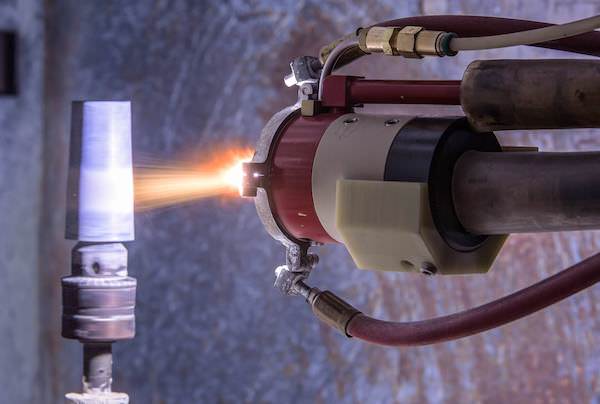
[Image above] A plasma torch deposits recycled magnet material. Credit: Ames Laboratory
We love our devices—computers, smartphones, tablets, and all the other tech that make our lives easier (or sometimes more complicated).
And whenever a new and improved model of a smartphone is introduced, for instance, early adopters are already in line waiting to get their hands on the latest and greatest.
But what happens to the old devices?
In 2016, the amount of e-waste generated globally was nearly 44.7 million metric tonnes, according to the latest United Nation’s Global E-waste Monitor Report. By 2021, that number is expected to grow to 52.2 Mt, up nearly 17%.
Unless we trade in our old devices when we upgrade to new ones, we are all contributing to the e-waste pollution problem.
Many companies already offer to take back that old tech, but one of the challenges in recycling old devices is the cost to extract the rare-earth metals. Apple recently entered the recycling game when they designed a pretty cool robot that disassembles iPhones and recovers high-quality materials, including rare-earth metals.
Last year researchers from Yale developed an electrochemical precipitation device that uses carbon nanotube filters to separate rare-earth metals and other elements from electronic devices.
But now, there is a simpler process to recycle rare earths from discarded electronics. Researchers at the U.S. Department of Energy’s Critical Materials Institute (CMI) recently devised a new method to extract rare-earth magnets from discarded hard disk drives—and turn them into new magnets for other uses. According to Ames Laboratory scientist Ryan Ott, who is on the research team at CMI, hard disk drives are the most common source of scrap magnet material.
“There are a lot of ways to go about getting the rare-earth elements out of e-waste, and some of them are very effective,” he explains in an Ames Laboratory news release, “but some create unwanted byproducts and the recovered elements still need to be incorporated into a new application.”
Currently, rare earths can be extracted from their original electronic sources, but some, such as magnets, cannot be reused in the same way. One common method for recycling rare earths is acid dissolution to recover the materials as oxides, Ott writes in an email. That process, he explains, can generate acid as a waste product.
The CMI team’s method is much simpler. After retrieving hard disk drive magnets from their source, the researchers remove their protective coatings, crush them into powder, and spray them with a plasma torch to make a coating 0.5–1 mm thick. The end result is a magnet that is not as powerful as the original—but still useful for many applications, such as magnets for small electronics, according to the release. And the new process is simpler than other conventional methods of extracting rare earths from discarded electronics.

Hard disk drive magnets that were used in a process to create new alloys. Credit: Ames Laboratory
“Here we have eliminated as many processing steps as we can and go straight from the discarded magnet to an end product, which is a new magnet,” Ott adds.
The added bonus of this process is that it reduces waste that is typically produced during manufacturing of smaller magnets out of larger bulk materials, Ott claims in the release.
As for whether or not their process could be used for other rare-earth materials, Ott says that it works best for magnet alloys. “Rare-earth-containing magnet alloys are best suited for recycling via this process, since new magnet alloys can be directly synthesized,” he writes. “The process, however, could be applied to other rare earth-containing materials.
“One of the biggest challenges in recycling rare earths is identifying an economically competitive process that yields material that can be incorporated into end-use products,” he adds in the email. “We are trying to achieve this by directly synthesizing new magnet alloys from recycled rare earth material with minimal processing steps and byproducts.”
Want to read more articles like this? Subscribe to the Ceramic Tech Today newsletter to continue to receive the latest news in the ceramic and glass industry right in your inbox! Visit this link to get started.
